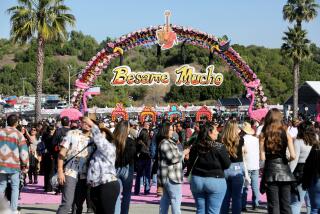Aman Folk Jumps for Days of Joy : Dance: The troupe will include a suite of celebratory dances from pre-war Croatia on its international bill at Saddleback College on Saturday.
Media images of a country torn asunder by war will be replaced with the multicolored vision of a joyous land when the Los Angeles-based Aman Folk Ensemble arrives in Orange County on Saturday with a new Croatian work.
That country’s villagers once gathered to celebrate through music and dance “just about every major turning point in the year and in life,” says Aman artistic director Barry Glass. “This was where community was built.
“Posavina,” a suite of traditional dances titled after a region in central Croatia, had its premiere last week in Los Angeles. Choreographed by Glass, it’s one of a dozen works from such diverse areas as Northern Mexico, central Asia and Appalachia on the well-known troupe’s program at Saddleback College in Mission Viejo.
“This is a piece I’ve been wanting to do for a while,” Glass said in a recent phone interview from the troupe’s Los Angeles office. “To me, it conveys in music, dance, costume and motif a time or a type of traditional society that was much more ordered than the modern world allows.”
Music, not movement style, always provides the inspirational spark for new works, said Glass, noting that “Posavina’s” accompaniment begins with slow, a cappella singing, performed by the dancers, in three-part harmony typical of the region.
From there, its mostly quick, upbeat melodies are created by a small string ensemble known as a tamburica , with instruments ranging from a string bass to a high-pitched bisernica , which looks something like a Ping-Pong paddle.
“I’m not Croatian,” said Glass, 46, “but I learned some of their dances as a child and during the early days of folk dancing in the U.S. Then, as I got more interested, I learned more from folklorists in Croatia . . . who were wonderful about taking us places and showing us steps.”
Traditional Croatian dance, represented elsewhere in Aman’s repertory, was influenced by dances of nearby Hungary, Italy and the Slovenian Alps. Thus, it is characterized by its variety of steps, from hops to stamps, and formations, from couples to large circles.
But the country’s most popular dance was the drmes , or shaking dance, composed of small, precise movements, Glass said. “When you do these little steps, there are tight, little bounces, and the body shakes.
“In Croatian dance, you’re either doing it well, or you feel like a clod,” he continued, citing another reason for liking it: “I’ve always been known for very precise foot work.”
*
Except in a few local professional troupes, today’s Croatians rarely perform their traditional dances, which, until a couple of decades ago, were key to such rites of passage as marriage, Glass said.
“These dances were part of a traditional society that was quite insular, but when people began to get TVs . . . traditional society began to change, and thus the dance began to change. If we lose the reasons for dancing, then we stop.”
“Posavina’s” colorful, handmade costumes, which Aman easily and inexpensively obtained in the early ‘70s, have nearly disappeared too.
“Traditional dress leaves even earlier than the dances,” Glass said. “They wear Western-style ready-mades now.”
In June, the troupe, which takes its name from the Eastern European and Middle Eastern pronunciation of “amen,” will mark its 30th anniversary with performances at UCLA, where it was founded.
*
The trip has had its ups and downs. The company’s U.S. touring schedule is up to three months this year, but it’s been as low as two weeks.
“Sometimes folk dance is trendy; sometimes it isn’t,” said Glass, a native Angeleno who’s been with the troupe for 27 years and still performs.
“In the late ‘80s, during the high-tech ‘me decade,’ the values we represent were not very much in vogue, and our bookings were way down.”
Part of the secret to survival is Aman’s touring educational program, which has continued to grow, Glass said, as well as the company’s performers and staffers--”these wonderfully dedicated people who continue to ride it out.”
As for attracting audiences, Glass somewhat reluctantly used “the A-word,” which he said often has had a negative connotation in the dance world.
“I think we’re accessible,” he said. “When people see us, they might not connect with everything, but they’ll connect with something.”
* Aman Folk Ensemble performs Saturday at 8 p.m. at the McKinney Theatre , Saddleback College, 28000 Marguerite Parkway, Mission Viejo. $14-$16. (714) 582-4656.
More to Read
The biggest entertainment stories
Get our big stories about Hollywood, film, television, music, arts, culture and more right in your inbox as soon as they publish.
You may occasionally receive promotional content from the Los Angeles Times.










